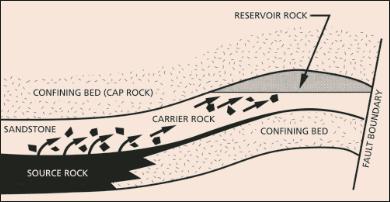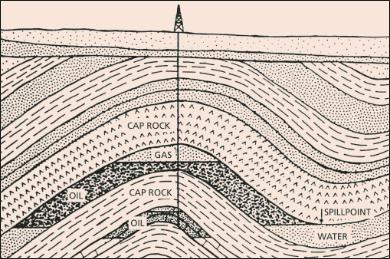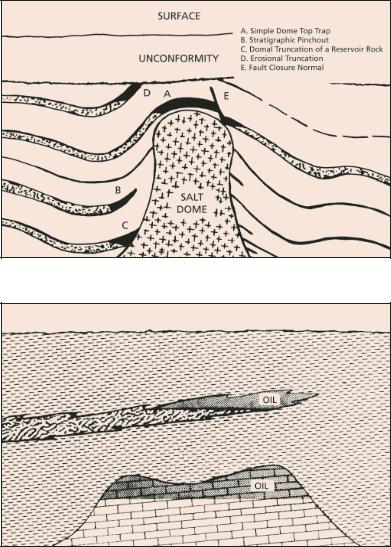
SpeakingOilGas
.pdfIn other locations a nearby volcano may erupt and ash is deposited, forming a rock known as tuff. At times a basin may be cut off from the sea altogether to form an inland lake. Vegetation surrounding the still waters dies, rots, is deposited, buried and compressed with other sediments and may eventually form seams of coal.
The rocks formed in the basin have varying degrees of porosity and permeability and the coincidence of these two properties is one of the keys to petroleum accumulation. A rock is termed porous if it contains voids and cavities between individual grains. It is permeable if the voids are connected so that fluid can flow through the rock.
Studies of sedimentary basins suggest petroleum is generated mainly in fine-grained shales or limestone on top of the more permeable part of a transgressive sequence, and below the more permeable part of a regressive phase. The more permeable rock is often associated with the near-shoreline environment and it is the minor fluctuations within transgressive and regressive phases that bring the potential source rocks and potential reservoir rocks together.
Crude oil
Crudes vary widely in appearance and consistency from field to field, ranging from thin yellow-brown mobile liquids to black viscous semi-solids. However they all consist essentially of hydrocarbons which are combinations of carbon and hydrogen atoms.
Classification is based on composition and is grouped into three main types — paraffins, asphalts and mixes.
•Paraffin-based crude is chiefly composed of isomers of paraffin and when distilled it leaves a residue of wax. Crudes of this type usually give good yields of high-grade lubricating oils.
•Asphalt-based crudes are mainly composed of naphthenes and very little paraffin. When distilled they leave a solid asphalt residue. Crudes of this type yield lubricating oils with viscosities that are more sensitive to temperature than paraffin-based crudes.
6 |
SPEAKING OIL & GAS |
•Mixed-base crudes, as the name suggests, contain substantial proportions of both paraffin wax and asphaltic matter along with some aromatic hydrocarbons.
There is considerable overlapping of these types and most crudes also contain a variety of impurities. Hydrogen sulphide and sulphur are the most common and the most problematic to the environment, and to the cost of production/refining. Other impurities include carbon dioxide, nitrogen, oxygen and some trace metals.
A yardstick for comparing crude oils is the API gravity (API stands for American Petroleum Institute). This value, which has been adopted as an industry standard, is actually a measure of density and is related to specific gravity using the formula:
API gravity (degrees) = |
141.5 |
-131.5 |
|
||
|
||
|
specific gravity |
|
|
(at 60˚ F) |
|
|
|
|
So, an API gravity of 10 degrees is equivalent to a specific gravity of one. The less dense the oil, the higher the API gravity, hence high gravity oils are known as ‘light’ crudes and low gravity oils are ‘heavy’ crudes. Australian and North Sea crudes tend to vary between 35 and 45 degrees API, whereas Middle Eastern crudes tend to be between 16 and 20 degrees API.
Natural gas
Natural gas is a mixture of gaseous hydrocarbons. It is mostly paraffinic and consists mainly of the simplest hydrocarbon, methane. It may also contain smaller amounts of ethane, propane, butane and some pentane, as well as impurities like sulphur dioxide, carbon dioxide and inert gases like nitrogen and helium.
Natural gas is generally found in conjunction with oil in a reservoir, but it can also be found on its own.
GEOLOGY |
7 |
Liquefied Natural Gas (LNG)
LNG is made by simply reducing natural gas to a liquid by cooling it to minus 161 degrees Celsius. This reduces the space natural gas occupies by more than 600 times, making the product easier to transport and store.
Liquefied Petroleum Gas (LPG)
The hydrocarbons propane and butane are gaseous under atmospheric conditions, but they can be easily liquefied by slight cooling and/or compression. The resultant LPG is used as a motor fuel and an industrial fuel as well as for domestic and commercial purposes.
Condensate
Fluids are contained in subsurface reservoirs at very high pressures and temperatures. This pressure is released and temperature lowered as the fluids are brought to the surface. Some of the gas content naturally condenses into a liquid during the journey and the resultant liquid is called condensate. At normal temperatures and pressures condensate is a light oil that can be refined into petroleum products and is therefore sold in the same way as crude oil. Wet gas contains significant amounts of condensate, dry gas does not.
Petroleum formation
Most petroleum geologists believe that oil and gas originate from organic matter of both plant and animal remains when it accumulates rapidly in fine-grained sediments under conditions of quiet deposition and a deficiency of oxygen.
The best pointer to the source material is the occurrence of porphyrin pigments and nitrogen in petroleum itself. The only known source for porphyrin pigments is the red colouring matter of blood (hemin) and the green colouring of plants (chlorophyll). Nitrogen is the essential component of amino acids which are basic components of animals and plants. Thus the conclusion is that plants and animals are the main source material for petroleum.
8 |
SPEAKING OIL & GAS |
An older and less popular theory proposes an inorganic origin which suggests petroleum hydrocarbons originate from volcanic gases, or even a simple reaction of carbon dioxide, water and catalysts with sunlight. Evidence for these theories is provided by methane gas which is found in volcanic gases as well as within the atmosphere of stars and in metamorphic rocks.
However the organic origin has by far the greatest following and geochemical studies indicate that petroleum is generated during the burial of sediment in a sedimentary basin. With increasing depth of burial the temperature of the source rock rises and, at a given heat value, the organic matter (referred to as kerogen) transforms into oil and gas. It is then driven from the source rocks during compaction in a movement known as migration.
The critical temperature at which crude oil is formed is generally in the range 110˚–130˚C. Oil is produced in the initial generation period, while gas forms at greater burial temperatures. Ultimately a source rock will be ‘burnt out’ if temperatures become too high. A source rock is mature when petroleum generation has begun, and post mature when it is burnt out. The area containing mature source rocks is often called the hydrocarbon kitchen.
Geochemical evidence also suggests that conditions favourable for significant petroleum generation normally do not occur above burial depths of around 1500 metres from the surface, although some instances of a ‘threshold’ depth of 600 metres have been found.
Indications are that the chemical changes are brought about by the combined effects of temperature, time, pressure and also catalysts in the source rock, as well as in the rocks through which the petroleum moves. The petroleum may undergo further changes via all these factors after entrapment.
GEOLOGY |
9 |

Petroleum migration
A vast majority of pores and cavities within rocks below the water table are filled with water. The balance may be filled with other liquids and gases.
Oil migration
The migration of oil and gas from a source rock to a reservoir rock is related to hydrology, fluid pressures and water movement. The rate of water movement may be small and measured in mere centimetres per year, but the effect of the hydrodynamic conditions can be very important to the movement of petroleum through the rocks. Migration is split into two types — primary and secondary.
•The primary phase refers to movement from the petroleum source to the reservoir. The oil and gas that has been generated and trapped in pore water is squeezed out during compaction of the rock. In this process the petroleum tends to enter only the larger pores because there is less displacement pressure needed than there is to enter smaller pores.
•The secondary phase of migration takes place within permeable rocks and can be either lateral or vertical movement.
10 |
SPEAKING OIL & GAS |
Once in a reservoir, gas and oil, being less dense than water, tend to move upwards. The upward movement continues until the hydrocarbons are restrained by a fine-grained, relatively impermeable layer. They can then follow the bottom of this layer until they either reach the surface where they form seeps, or they reach a position from which they cannot move further and are trapped.
The path of migration may cover tens or hundreds of kilometres and much recent study has been done to try and relate the size of the hydrocarbon kitchen, and hence the volume of hydrocarbons likely to be produced, to traps in the surrounding areas. For instance, if the kitchen is small, it is probable only the nearest traps will be oil bearing. If the kitchen is large and deep, gas may have replaced the oil in traps closest to the generation point and this oil may have been forced into more distant traps. It is also known that oil is often released from a source rock in periodic pulses — like a slowed down geyser. Time and migration can change the hydrocarbons such that different types of oil may be found in different traps along the migration path even though they all came from the same original source rock.
The characteristics of reservoir rocks and the types of hydrocarbon entrapments are at the heart of the petroleum exploration and production industry.
Petroleum reservoirs
Any rock that has sufficient porosity and permeability to contain significant volumes of hydrocarbons is considered to be a reservoir rock. The porosity may occur between grains, within grains, or in joints and fractures. Porosity and permeability may be original or they may be due to alteration during burial or by later earth movements like faulting and folding. Sandstones and carbonates (limestone and dolomite) are the most common reservoir rocks.
The range of porosity in reservoir rocks is between one per cent and 40 per cent, while permeability can vary between less than one millidarcy and more than 1000 darcies. The textbook commercial oil reservoir will
GEOLOGY |
11 |
have a porosity of 20 per cent or better and a permeability of more than 100 millidarcies. Gas production has lower requirements. However, there are many exceptions to the norm. Some reservoirs have little pore space, but contain oil and/or gas in fractures and fissures. Others have good porosity, but permeability is too low for production and they are produced via fractures. Permeability can also be stimulated artificially by mechanical or chemical fracturing.
Most reservoirs have marked differences in permeability from one layer to the next and, if they are produced too quickly, the hydrocarbons will only flow from the highly permeable layers. Oil or gas in the finer grained sections will be cut off by rising water and therefore be lost to production.
The most important characteristic for production, however, is the thickness of the reservoir. Some are massive homogenous sands, while others are thin stringers of sandstone interspersed with impermeable layers of other material. Thus the term net pay (total thickness of all the permeable layers), as opposed to gross pay (total thickness of the whole reservoir zone including both impermeable and permeable layers), is important in reservoir assessment.
Petroleum traps
Traps are generally grouped into three major categories — structural, stratigraphic, and a combination of structural and stratigraphic.
Structural traps
The simplest structural trap is one formed by the folding of rock layers into a dome or elliptical dome shape and is known as an anticline or an anticlinal trap. It is virtually a ‘buried hill’ and contour lines drawn in a plan view of the structure will be roughly circular or elliptical. Hydrocarbons may migrate into this structure from all sides, accumulating in the top where an impervious roof formation, called a cap rock or seal, brings migration to an end.
12 |
SPEAKING OIL & GAS |

Anticlinal traps and spillpoints
The structure is rarely that simple in practice and it is usually complicated by faulting, complex secondary folding and changes of porosity within the reservoir. Up to 50 separate reservoirs have been recorded in some anticlinal traps.
A fault trap is formed when a fault plane (a line of displacement of the earth’s crust) interrupts the direction of migration of hydrocarbons. The accumulation occurs when the oil or gas is prevented from proceeding up-dip by fine-grained material in the fault itself, or by an impermeable layer adjacent to the reservoir on the other side of the fault.
However, entrapment will only occur if faulting pre-dates hydrocarbon generation and migration, and if the fault completely truncates and seals the reservoir. Some faults do not seal effectively and can become conduits or ‘escapes’ for hydrocarbons into higher formations, or even the surface. Often a fold component is present with faulting.
GEOLOGY |
13 |

Trap in dipping strata formed by fault plane
Salt layers have the ability to flow plastically at relatively low temperatures and, at depth, they are often less dense than the immediately overlying sediments. Because of this gravitational instability, salt tends to rise vertically, punching its way through the overlying sedimentary column. The so-called salt dome structure that is produced provides a number of trapping mechanisms including faults and anticlines at the head of the structure, against the impervious flanks of the salt column itself and against the truncated, overturned or faulted layers along the flanks. Salt dome traps are common in the Gulf of Mexico petroleum province.
Stratigraphic traps
Stratigraphic traps are defined as those in which the reservoir is sealed due to depositional or alteration processes rather than structural movements of the earth’s crust. They are more difficult to find, but when discovered they have provided some of the largest fields in the world.
14 |
SPEAKING OIL & GAS |

Salt dome traps
Stratigraphic traps: organic reef embedded in shale, and wedged-out sand
GEOLOGY |
15 |
